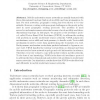Free Online Productivity Tools
i2Speak
i2Symbol
i2OCR
iTex2Img
iWeb2Print
iWeb2Shot
i2Type
iPdf2Split
iPdf2Merge
i2Bopomofo
i2Arabic
i2Style
i2Image
i2PDF
iLatex2Rtf
Sci2ools
91
Voted
WASA
2009
Springer
2009
Springer
Void Avoidance in Three-Dimensional Mobile Underwater Sensor Networks
Mobile underwater sensor networks are usually featured with three-dimensional topology, high node mobility and long propagation delays. For such networks, geographic routing has been shown to be very suitable. However, routing voids pose great challenges on the greedy policy used in most geographic routing protocols. The problem is more severe for underwater sensor networks because of node mobility and threedimensional topology. In this paper, we propose a void avoidance protocol, called Vector-Based Void Avoidance (VBVA), to address the routing void problem in mobile underwater sensor networks. VBVA adopts two mechanisms, vector-shift and back-pressure, to handle voids. Vector-shift mechanism is used to route data packets along the boundary of a void. Back-pressure mechanism routes data packets backward to bypass a concave void. VBVA handles the routing void problem on demand and thus does not need to know network topology and void information in advance. Therefore, it is very robust ...
| Added | 27 Jul 2010 |
| Updated | 27 Jul 2010 |
| Type | Conference |
| Year | 2009 |
| Where | WASA |
| Authors | Peng Xie, Zhong Zhou, Zheng Peng, Jun-Hong Cui, Zhijie Shi |
Comments (0)

